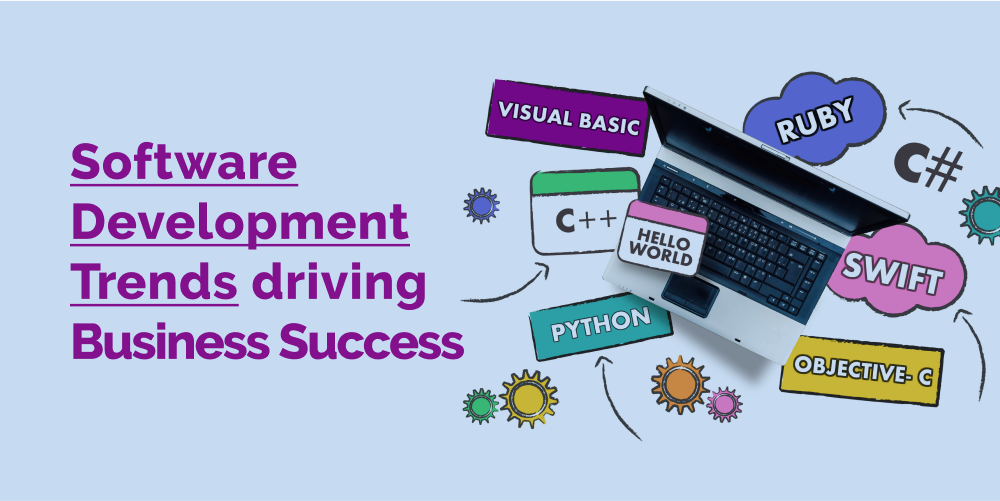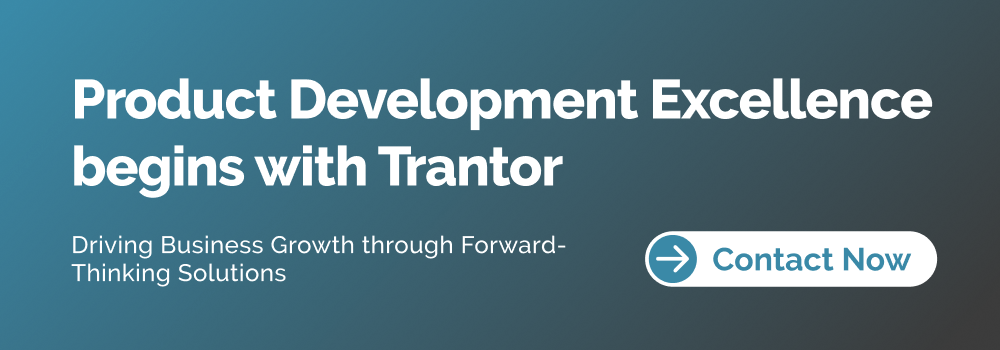Software Development, zBlog
Software Development Trends Driving Business Success in 2024
trantorindia | Updated: September 25, 2023

Introduction
In today’s highly competitive and rapidly evolving technological landscape, leveraging the latest software development trends is imperative for business leaders seeking to drive innovation, unlock growth, and deliver sustainable success. This article provides an in-depth analysis of key software development trends, their business impacts, and how leaders can strategically capitalize on these trends to outperform the competition.
The Growing Importance of Software in Business
Software is penetrating deeper across industries, transforming how companies operate, engage customers, and create value. As per Gartner, worldwide IT spending is projected to reach $4.5 trillion in 2024, reflecting the indispensable role of software investments. With software powering everything from operations to products and services, it has moved from a support function to a key business driver and competitive differentiator. Business leaders must recognize software-led innovation as a top strategic priority to thrive in the digital economy.
Key Software Development Trends Reshaping Businesses

Several disruptive technology trends in software development are reshaping industries and redefining the foundations of competitive advantage. Forward-thinking leaders are proactively leveraging these trends to enhance operational agility, productivity, customer engagement, and value creation.
1. The Ascent of Artificial Intelligence (AI)
AI adoption is accelerating across sectors, enabling breakthrough capabilities. As per Gartner, 72% of businesses are already using AI in some form. [6] By automating complex tasks, generating actionable insights from data, and enhancing decision-making, AI augments human capabilities and unlocks enormous potential. Leaders must invest in building integrated AI/ML solutions, skillsets, and cultural readiness to establish a sustainable competitive edge.
2. The Cloud Revolution
Cloud computing has evolved into an essential business enabler, offering on-demand services, scalability, and business continuity. The global cloud market is projected to reach $623.8 billion in 2024 as per IDC. Cloud enables innovation, flexibility, and collaboration advantages which were inconceivable earlier. Leadership teams must holistically embrace multi-cloud strategies combining PaaS, IaaS, and SaaS services to drive agility, and cost efficiency and accelerate growth.
3. The Criticality of Cybersecurity
As technology expands the digital attack surface, cyber risks pose severe threats. With cybercrime costs projected to reach $10.5 trillion annually by 2025, cybersecurity is now a boardroom priority. Business leaders must drive enterprise-wide cyber resilience by implementing robust cyber defense platforms, comprehensive risk management, security-by-design approaches, predictive threat analytics, and fostering a cyber-smart culture.
4. The Internet of Things (IoT) Ushers in New Possibilities
IoT is enabling an interconnected world where devices and systems seamlessly communicate real-time data. According to Cisco, IoT connections are expected to reach 500 billion by 2024 as adoption proliferates. Leaders must tap into the wave of IoT and drive revenue growth, enhance customer engagement, optimize operations, and develop innovative connected products and services.
5. The Low-Code/No-Code Revolution
Low-code/no-code app development platforms empower businesses to build solutions faster with minimal coding. This market is projected to reach $27.2 billion as per Gartner. Leaders can leverage these tools to rapidly prototype applications, test new ideas, and empower non-technical teams – enabling agility and innovation at scale.
6. Agile Methodologies Mainstream Adoption
Agile development, focused on iterations, user collaboration, and rapid adaptation is vital today. As per VersionOne, over 80% of software projects will be using agile methodologies by 2024. Leaders must champion agile culture, and practices, and reorient structures to empower autonomous cross-functional teams that can swiftly deliver innovation.
7. DevOps and CI/CD Accelerate Delivery
DevOps integrates development and operations, enabling continuous development/deployment. Combining DevOps with CI/CD (continuous integration/continuous deployment) pipelines and cloud infrastructure results in faster release cycles and improved quality. Leaders need to undertake the organizational and cultural shift to embed DevOps and implement end-to-end automation of build, test, and release processes.
8. Mobile Apps Dominate Digital Experiences
Mobile apps are dominating digital experiences with users spending 3+ hours per day as per Statista. The global mobile app market is projected to reach $936.2 billion in 2024. As per Apptentive, 75% of businesses now have a mobile app strategy. By building feature-rich, hyper-personalized cross-platform mobile apps leveraging trends like AI, leaders can engage customers in compelling new ways.
9. Blockchain Opens New Possibilities
Blockchain enables tamper-proof, transparent transactions. The global blockchain market is forecasted to reach $23.6 billion in 2024. While still early for enterprises, 80% are exploring the technology as per PwC.] Leaders should identify high-value applications in areas like supply chain, identity, payments, and data sharing to pilot blockchain and build expertise.
Strategically Leveraging Software Development Approaches

Beyond tracking technological advancements, business leaders need to adopt modern software development approaches to harness the potential of these trends fully
Embracing Agile Methodologies
Agile development, focused on iterations, user collaboration, and rapid adaptation is vital today. As per VersionOne, over 80% of software projects will be using agile methodologies by 2024. Leaders must champion agile culture, and practices, and reorient structures to empower autonomous cross-functional teams that can swiftly deliver innovation.
Adopting DevOps and CI/CD
DevOps integrates development and operations, enabling continuous development/deployment. Combining DevOps with CI/CD (continuous integration/continuous deployment) pipelines and cloud infrastructure results in faster release cycles and improved quality. Leaders need to undertake the organizational and cultural shift to embed DevOps and implement end-to-end automation of build, test, and release processes.
Focusing on Speed and Quality
In dynamic markets, being first provides a substantial competitive advantage. Slashing development cycles can help seize opportunities and stay ahead. As per McKinsey, the average time to market for software applications is 12 months. Simultaneously, software defects cost economies nearly $250 billion annually as per IBM. Leaders can engender a culture obsessed with quality and speed by championing design thinking, user-centricity, and practices like shift left testing,
Maintaining Focus on Technical Debt and Legacy Modernization
The fast pace of change necessitates balancing innovation investments with managing technical debt and modernizing legacy systems. On average, software developers spend 20% of their time on maintenance and bug fixing as per Stack Overflow. Through a focus on architecture, automation, decomplexifying codebases and selectively re-platforming legacy systems, technology debt can be systematically addressed, freeing up resources for transformation.
Making Security a Priority Across the SDLC
With data breaches having spiraling costs, security needs to be woven into the entire software development lifecycle. Leaders must drive practices like secure code reviews, threat modeling, penetration testing, and security automation to enable proactive detection and mitigation of vulnerabilities.
Enabling Platformization and API Strategies
Leveraging API-driven architectures and platform business models fuel innovation and partnerships. Leaders must invest in building API and microservices-powered platforms to open up ecosystems for collaboration and co-creation.

Key Application Areas Powering Digital Transformation

Several software application domains enable businesses to harness emerging trends and deliver next-gen customer and employee experiences.
Capitalizing on Mobile App Market Opportunities
Mobile apps are dominating digital experiences with users spending 3+ hours per day as per Statista. The global mobile app market is projected to reach $936.2 billion in 2024. As per Apptentive, 75% of businesses now have a mobile app strategy. By building feature-rich, hyper-personalized cross-platform mobile apps leveraging trends like AI, leaders can engage customers in compelling new ways.
Exploring Blockchain’s Potential
Blockchain enables tamper-proof, transparent transactions. The global blockchain market is forecasted to reach $23.6 billion in 2024. While still early for enterprises, 80% are exploring the technology as per PwC. Leaders should identify high-value applications in areas like supply chain, identity, payments, and data sharing to pilot blockchain and build expertise.
Tapping into Low-Code Citizen Development
Empowering business teams to build solutions is a key imperative. Low-code app dev platforms like Power Apps and Appian bridge this gap. Leaders must provide governance while promoting citizen development to harness business insights and agility.
Driving Intelligent Automation
AI-powered intelligent automation can transform operations by eliminating repetitive tasks. Leaders must identify automation opportunities and implement solutions covering process mining, computer vision, NLP, and decision intelligence to enable growth with optimized cost structures.
Implementing Advanced Analytics and BI
Deriving insights from data is critical for strategic decisions and value creation. Business intelligence and advanced analytics capabilities need to be democratized across the enterprise to empower data-driven thinking at all levels.
Strengthening Cyber Defense Platforms
Today’s complex cyber threat landscape demands integrated cyber defense platforms spanning threat intelligence, identity management, end-point security, managed detection/response, and GRC. Leaders need to continuously evaluate and strengthen their cyber resilience posture by leveraging cloud-enabled security offerings.
Key Takeaways for Executives

- Make software-led innovation central to corporate strategy and invest in talent, capabilities, and culture to harness the power of software.
- Proactively adopt artificial intelligence, cloud computing, cybersecurity, IoT, and low-code platforms to drive competitive advantages.
- Accelerate application development and delivery through agile, DevOps, and CI/CD while ensuring quality.
- Tap into mobile apps, blockchain, automation, and advanced analytics to reimagine customer and employee experiences.
- Foster a culture obsessed with speed, user-centricity, platform thinking, and security across the software lifecycle.
Conclusion
In the dynamic world of technology, the outcomes of technological shifts are determined by how effectively leaders harness them. When businesses blend their forward-thinking comprehension of software development trends with impeccable execution, they unlock the vast potential for generating value for stakeholders. To prosper in an increasingly digital and software-centric landscape, leaders must embed strategic software mastery at the core of their vision. The moment to take action is upon us, as those who hesitate face the risk of fading into irrelevance.
At Trantor, we deeply appreciate the immense value of collaborating with renowned industry platforms such as Salesforce, SAP, UiPath, and LeanIX. Through our esteemed partnerships, we have the privilege of delivering truly top-tier solutions to our clients, capitalizing on the collective strengths of our combined expertise. Our partners play a pivotal role in enabling Trantor to provide customized digital products, a distinction that has garnered us international recognition. The real magic happens when we synergize, as we take great pride in our agile team’s contributions to every partnership. However, what truly excites us is the collective potential we unlock for clients by marrying Trantor’s adaptability with our partners’ capabilities.




